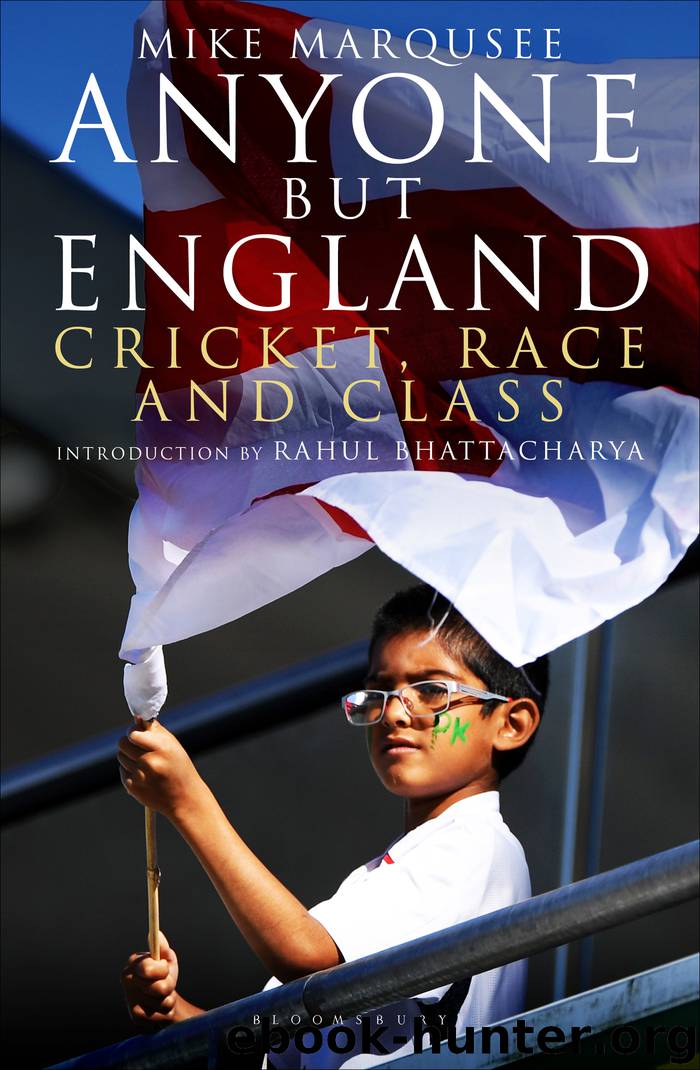Anyone but England by Mike Marqusee

Author:Mike Marqusee
Language: eng
Format: epub
Publisher: Bloomsbury Publishing
Published: 2016-03-13T16:00:00+00:00
6
Politics and the National Game
South Africa:England’s cause • The game’s revenge
• The new order • Sharjah:global cricket • Argentina, Ireland,
USA:apostate nations • Market and nation in Indian cricket
• The supreme drama of Test cricket
Throughout the twenty-year isolation of South Africa from world cricket, the battle cry of apartheid’s apologists was ‘Keep politics out of sport!’ They appealed to a world transcending politics, a community of cricket, which was, in fact, the community of imperial white supremacy.
Of course, it was the English who brought cricket to South Africa. But, at first, they brought it mainly to black people. Fostered by missionary schools and military outposts, black South African cricket grew steadily in the second half of the nineteenth century. An educated, enfranchised, English-speaking black petty bourgeoisie emerged in the Cape, and it adopted cricket as part of the apparatus of civilization which, it hoped, would enable it to meet the white colonizers on their own terms. Cricket, with its level playing field, was a way of claiming a place in and protection under the British empire. For John Tengo Jabavu, a black politician, newspaper owner and chairman of two cricket clubs, the virtue of cricket was that it was ‘calculated to make the Europeans and natives have more mutual trust and confidence than all the coercive and repressive legislation in the world’.
With the discovery of gold in the Transvaal in 1886, British interests in South Africa changed. Capital from the City of London facilitated rapid industrial development, which reduced the black population to cheap labour. Cricket was supplanted among the black proletariat of the Transvaal by football and boxing. The mining companies, including Lord Harris’s Consolidated Goldfields, encouraged football in their company hostels as a cheap diversion for the workforce. At the same time, the British began to restrict the long-established black franchise in the Cape.
English cricketers began regular tours of South Africa in 1888. Standards were low, but the power of South African gold and the need to integrate the feisty Boers into the empire led the MCC, many of whose members had investments and family in South Africa, to establish close ties to the newly-founded all-white South African Cricket Association (SACA). In 1892, professional members of WW Read’s England squad played a match against Cape Malays (the amateurs refused to take part). It was to be the last time a touring England side faced a black South African side until December, 1993. During the match, the bowling of Krom Hendrick, a ‘Coloured’ man, impressed the English players, who were surprised when he was left out of the South African side that toured England in 1894, on the instructions of Cecil Rhodes, the Cape Colony Prime Minister who financed the tour.
As British designs on the whole of South Africa became clearer, tensions with the Afrikaners mounted. When Lord Hawke’s side visited South Africa in 1898–99, the captain refused to meet Kruger, the Afrikaner President of the Transvaal Republic, and announced that he had brought cricket to South Africa to ‘comfort the English’.
Download
This site does not store any files on its server. We only index and link to content provided by other sites. Please contact the content providers to delete copyright contents if any and email us, we'll remove relevant links or contents immediately.
| Cricket | Field Hockey |
| Lacrosse | Rugby |
| Track & Field | Volleyball |
Going Long by Editors of Runner's World(1920)
The Happy Runner by David Roche(1818)
Yoga For Dummies by Georg Feuerstein(1204)
Legacy by Kerr James(1054)
Becoming Boston Strong by Amy Noelle Roe(1022)
Winger by Smith Andrew(996)
The Little Red Book of Running by Scott Douglas(884)
Bowerman and the Men of Oregon by Kenny Moore(882)
Wodehouse At the Wicket by P.G. Wodehouse(864)
5050 by Dean Karnazes(838)
The Way of the Runner by Adharanand Finn(834)
Running Your First Marathon by Andrew Kastor(829)
Swim, Bike, Run - Eat by Tom Holland(828)
The Coming Storm by Nigel McCrery(777)
Spiked (Blocked Book 3) by Jennifer Lane(771)
Blade Runner by Oscar Pistorius(752)
The Shared Origins of Football, Rugby, and Soccer by Christopher Rowley(748)
The Amazing Test Match Crime by Adrian Alington(747)
The Grade Cricketer by Dave Edwards(745)
